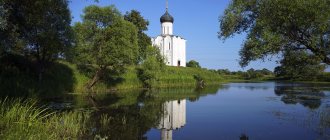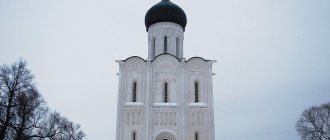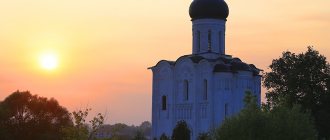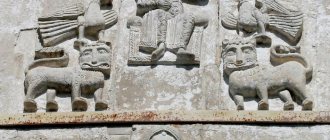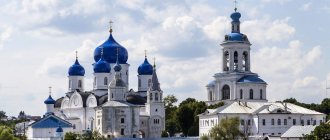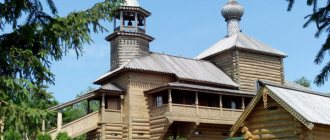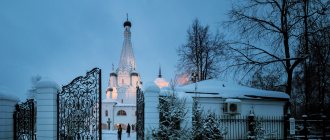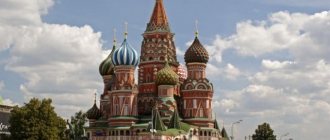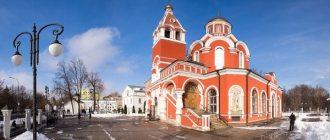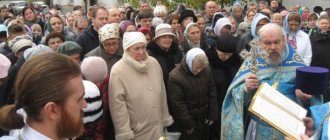The Holy Bogolyubsky Convent in Bogolyubovo and the nearby Church of the Intercession on the Nerl are the places where you want to return again and again. The magnificent ancient Russian architecture of the 12th century and the beautiful nature of the Vladimir land will not leave anyone indifferent. It’s good here at any time of the year, but especially in early May, when the Nerl and Klyazma flood.
Bogolyubovo from the road
Holy Bogolyubsky Monastery
The Holy Bogolyubsky Convent is famous for the fact that fragments of the castle of the Vladimir-Suzdal prince Andrei Bogolyubsky (born around 1111, died in 1174), son of Yuri Dolgoruky, the legendary founder of Moscow, have been preserved here. This is the only partially surviving ancient Russian building of civil architecture.
According to legend, the prince had an apparition of the Mother of God, which predetermined the choice of this place for the construction of a country residence and a temple in honor of the Nativity of the Virgin Mary . What has survived from the castle is the staircase tower, which was discovered in the 1950s under a layer of later layers, as well as the covered passage to the choir. In the 18th century, a tented bell tower was built over the tower.
On June 29, 1174, Prince Andrei Bogolyubsky was killed in his castle. Perhaps this was the reason that already in the 13th century, under the successors of Andrei Bogolyubsky, a monastery was built here. In 1855-1866, on the territory of the monastery, according to the design of the architect K.A. Ton, the founder of the “Russian-Byzantine style,” a cathedral was erected in honor of the Bogolyubskaya Icon of the Mother of God . In 1923, the monastery was closed, and at the beginning of the next year it was transferred to the museum department. In 1991, part of the premises was returned to the church, and in 1997 a monastery was reopened on the territory.
Cathedral of the Nativity of the Blessed Virgin Mary in the Holy Bogolyubsky Monastery
Cathedral of the Bogolyubsk Icon of the Mother of God
Bell tower of All Saints with the gate church of the Assumption of the Blessed Virgin Mary
Fragments of Andrei Bogolyubsky's castle have been preserved as part of the Church of the Nativity of the Blessed Virgin Mary. This is the lower tier of the bell tower and the transition to the choir of the church. The church itself is plastered and whitewashed, and the castle walls are made of white stone, with characteristic arched belts.
Archaeological excavations by the Institute of Archeology of the Russian Academy of Sciences in 2021, which were carried out on the territory of the temple complex in Bogolyubovo, brought new results. According to corresponding member of the Russian Academy of Sciences Vladimir Sedov, “Parts of the cathedral discovered during excavations in 2021 provided new material both about the plan of the cathedral and about the origin of Vladimir-Suzdal architecture in general. Now we understand that, most likely, craftsmen from Lombardy and Emilia-Romagna participated in the construction of this temple.” Thus, the version about the European roots of Vladimir-Suzdal white stone architecture received new evidence.
♦ Read about why white stone—limestone—was used as a building material in the construction of temples and other structures in Vladimir-Suzdal Rus' in the article “Temple complex in Kideksha: at the origins of white stone architecture in Rus'.”
Church of the Nativity of the Blessed Virgin Mary in the Holy Bogolyubsky Monastery
A complex of buildings around the Church of the Nativity of the Virgin in the 12th century. Reconstruction of N.N. Voronin (option)
A complex of buildings around the Church of the Nativity of the Virgin in the 12th century. Reconstruction of N.N. Voronin (option)
Surviving fragment of Andrei Bogolyubsky's castle
Justinovsky building in the monastery
Cathedral of the Bogolyubsk Icon of the Mother of God
Church of the Nativity of the Blessed Virgin Mary
Bell tower
Church of the Intercession on the Nerl in winter
A memorial plaque with the generally accepted date of construction of the Church of the Intercession on the Nerl. Historians dispute this date, but that’s why they are scientists.
Name
The temple is dedicated to the Intercession of the Blessed Virgin Mary. The history of the Feast of the Intercession of the Mother of God is still full of gaps and there is no consensus on the place of its origin. The traditional point of view connects the beginning of the veneration of the Intercession in Rus' with the Vladimir-Suzdal lands and the name of Prince Andrei Bogolyubsky. It is believed that the Feast of the Intercession was personally established by the Prince of Vladimir without the consent of the Kyiv Metropolitan and the Patriarch of Constantinople, which at that time was unheard of insolence. The holiday was supposed to indicate the special protection of the Mother of God for the Vladimir land. Its establishment had far-reaching plans: Andrei Bogolyubsky intended to make Vladimir the new capital of Rus', equivalent to Kyiv. It is alleged that this holiday never existed in Byzantium and at that time not a single Christian church in Rus' knew it. It is known for sure that the Church of the Intercession on the Nerl is the very first temple in Rus' dedicated to the Intercession of the Most Holy Theotokos, but there is no specific date for the consecration of the church in honor of the Feast of the Intercession in the chronicles. Some historians argue that the holiday, however, came from Byzantium; recently, opinions have become popular that the holiday was established in Kyiv.
Location
It is difficult to find a more inconvenient place to build a church than the place where the Church of the Intercession on the Nerl stands. The church is incredibly beautiful when it rises like a lonely candle above the flooded meadows, while the hollow water rises around more than three meters, but this beauty required the most complex engineering calculations. It is unclear where professional knowledge of structural geology came from in the 12th century and how builders were able to design a foundation that could withstand more than 850 spring floods.
Part of these secrets were revealed during archaeological research carried out in the 1950s by N. N. Voronin, one of the leading Soviet experts on ancient Russian architecture. As it turned out, the builders laid a rubble foundation made of cobblestone 1.60 meters deep, resting its base on a layer of continental hard-plastic Jurassic clay. Strip foundations for walls and pillars were laid in the rubble foundation. Next, the builders erected the foundations of the walls and pillars of the temple from carefully hewn, tightly fitted stone with a total height of 3.70 meters, periodically filling it outside and inside with clayey sandy loam soil, which was compacted tightly. This is how an artificial hill grew, reliably covering the foundations of the temple with a total depth of 5.30 meters from the spring floods lying in its massif. On this foundation, raised above the flood mark, the temple was erected. The builders did not stop there - they lined the surface of the hill with white stone slabs and laid stone gutters to drain sediment. This complex engineering structure underlies the Church of the Intercession on the Nerl. Since all the structural elements of the building were carefully calculated, the church stood without problems for eight and a half centuries, and perhaps it will stand for as long.
Thanks to archaeological research in the 50s of the last century, it became clear that the temple was originally surrounded by open galleries 5.5 meters high with ceilings, and in the southwestern corner there was an internal staircase that led to the choir. N.N. Voronin was the first to reconstruct the original appearance of the church on the Nerl. If you are interested in more detailed information on this matter, then you can refer to N. N. Voronin’s article in the journal “Soviet Archeology”, where he describes the results of his archaeological research into the Church of the Intercession on the Nerl.
Spill on the Nerl and Klyazma
After visiting the Holy Bogolyubovsky Convent, it is worth walking or driving to the Bogolyubovo railway station to admire the endless expanses of Bogolyubovsky Meadow . During high water in the spring, it goes under water. In the distance, on a small hill in the middle of the water, you can see the Church of the Intercession on the Nerl. Trees stand in water. An unusually picturesque picture.
I took these photos of the spill in early May. The peak of the flood was already behind us, but the water was still high, flooding many trees and even buildings.
Railway in Bogolyubovo
Panorama of the Holy Bogolyubsky Monastery
From the height of the passage above the railway tracks in Bogolyubovo the flood of the Nerl and Klyazma is clearly visible
Spill
Spill
Pedestrian bridge over the railway in Bogolyubovo
Bogolyubovsky meadow under water
During high water, trees near the station stand in water
Trees in the water
The blue spring sky is beautifully reflected in the water
Bogolyubovsky meadow under water
Railway bridge over the Nerl
The Bogolyubsky Monastery looks very unusual against the background of the railway.
Holy Bogolyubsky Monastery and railway
The pedestrian bridge over the railway tracks offers a magnificent view. Against the background of white walls, the slightly grayish, white stone walls of Andrei Bogolyubsky’s castle clearly stand out.
Panorama of the Holy Bogolyubsky Monastery
White stone carving
Like many temples of Vladimir-Suzdal architecture, the church is decorated with white stone carvings. On its three facades we will see a composition depicting the psalmist king David sitting on the throne. On both sides of it are depicted doves and figures of lions. Even lower is a belt of 21 female masks, symbolizing the dedication of the temple to the Blessed Virgin Mary.
Initially, around the church there was an open white stone gallery 5.5 meters high, the base of which was white stone pillars. The floor of the galleries was covered with bright majolica tiles, and in the southwest corner there was a staircase along which one could climb to the choir.
The parapet was decorated with carvings depicting griffins and other mythical animals, including leopards. It has been established that the figure of a rearing leopard is the oldest sign of the Russian people, preserved to this day in the coat of arms of Vladimir. The meaning of the remaining figures remains unclear.

